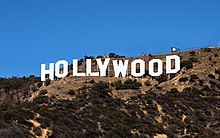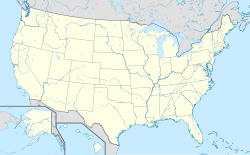Hollywood
| Hollywood | ||
|---|---|---|
|
|
||
| Coordinates | 34 ° 5 '33 " N , 118 ° 19' 12" W | |
| Basic data | ||
| Country | United States | |
| California | ||
| ISO 3166-2 | US CA | |
| local community | Los Angeles | |
| surface | 65.3 km² | |
| resident | 153,627 (2000) | |
| density | 2,354.4 Ew. / km² | |
| founding | 1903 | |

Hollywood ( ) [ ˈhɑːli.wʊd ] ( English for holly forest ) is a district of Los Angeles in the US state of California with 153,627 inhabitants (as of 2017). World famous Hollywood was as a center of the American film industry , which is why his name often representative of the entire American film industry group whose myth to the emergence of common synonyms such as Dream Factory (English: dreamfactory ) or Tinseltown (of English tinsel for Glitter jewelry led).
History of hollywood
In 1853 there was only one adobe hut in what is now Hollywood . Around 1870 a flourishing rural community had developed in the area, in which different plants of native and exotic origin were grown. Its residents called it the Cahuenga Valley , after the nearby Cahuenga Pass . The street name Cahuenga Boulevard still reminds of this today .
Hollywood received its current name in 1886 from the Whitley family. At that time, Harvey J. Whitley, who immigrated from Oklahoma, began working as a real estate agent here . Around 1900 the community had a post office, a newspaper, a hotel, two markets and 500 residents. On November 14, 1903, Hollywood was recognized as an independent community after the positive vote of its voters. Only seven years later, in 1910, the inhabitants of Hollywood voted in a plebiscite of annexation to Los Angeles. The main reason for this was the access to the water supply of the neighboring city. On behalf of the Los Angeles Water Administration , the Los Angeles Aqueduct had been built since 1908, which was supposed to transport inexpensive drinking water in large quantities from the Owens Valley to the dry southern California. With the help of this water, the city of Los Angeles was able to incorporate a large number of neighboring communities. Other municipalities with their own water supply such as B. Burbank are still independent today for the same reason.
In the same year 1910, the film director DW Griffith from New York visited Hollywood with his cast of actors to shoot the film In Old California . The film - the first to be produced in Hollywood - premiered on March 10, 1910. Griffith and his staff stayed several months and completed a number of films before returning to New York. Hollywood's real rise began the following year, when David Horsley's Nestor Company opened the first film studio here . In the same year settled 15 more, Independents (Independent) said companies from New York , then the center of the film industry to Hollywood over. One of the pioneers from the very beginning was Carl Laemmle from Laupheim in Württemberg , founder of the Independent Moving Pictures Company . In the following years, more and more film studios relocated to Hollywood and some surrounding areas (e.g. Burbank ) in order to escape the monopoly of the Motion Picture Patents Company (MPPC) that prevailed in New York . By 1915, the majority of all American films were being produced in the Los Angeles area.
There were many reasons for this move. In addition to the economic ones, it was the more suitable climate and the more even length of day (at that time there was no adequate artificial light , so one shot either outdoors or in a studio with a glass roof or something similar). Another decisive factor was undoubtedly the great distance to New York, from where the powerful MPPC threatened all non-affiliated companies with heavy fines and license fees.
In the 1920s, Hollywood had become the world capital of the film industry . This began to be celebrated to an increasing extent during this time through magnificent or exotic cinema palaces , such as B. the Grauman's Chinese Theater or the Egyptian .
The film industry came after the Second World War, the television and the music industry added: January 22, began in 1947 KTLA , the first TV channel of the city, with the transmission mode. In 1952, CBS Television City opened at the intersection of Beverly Boulevard and Fairfax Avenue , one of the largest television studios at the time . Even today in the by architects Pereira & Luckman TV shows such constructed buildings. B. Dancing with the Stars or The Late Night Show .
A few years later, the Capitol Records Building (1956) on Vine Street , planned by Louis Naidorf ( Welton Becket & Associates ), was added to the modern architectural sights of Hollywood . The building became a cinematic staffage for disaster films and, as an architectural icon of the International Style of the 1950s, advanced to become a symbol of the city.
After the architectural wealth of Hollywood was threatened by neglect and demolition for decades, the structures that have been preserved have been increasingly respected since the 1980s. Hollywood Boulevard, for example, has had an entry in the National Register of Historic Places since 1985 . At the same time, many areas in Hollywood, especially around Hollywood Boulevard, are becoming increasingly gentrified . The Red Line , opened in 1999, also contributed to this , a subway line of the Los Angeles Metro , which has since connected the central business district of Hollywood with downtown Los Angeles .
In 2002 citizens from Hollywood and San Fernando Valley tried to enforce independence from Los Angeles in a referendum . Both requests, however, fell far short of the required number of votes.
Since the completion of the Red Line subway of the Los Angeles Metro from Union Station via Downtown to North Hollywood , the district has above-average public transport connections by US standards. As a result, the city planners decided to provide for a highly dense development with high-rise buildings on Sunset Boulevard , Hollywood Boulevard and Vine Street and thus to take advantage of the transport options of the subway. By 2030, compared to 2010, the population is planned to increase by 25% in the quarter, concentrated in the vicinity of the underground stations. The plans are controversial because they would change the character of Hollywood.
Hollywood as a film city
In the Hollywood Hills above the city is the famous Hollywood Sign , large letters that were erected in 1923 as "Hollywoodland" to advertise the sale of real estate. As the letters continued to deteriorate, the Hollywood Chamber of Commerce, with the support of some celebrities, put up a new lettering for the city's 91st birthday in 1978.
The largest film studios in Hollywood currently include Universal Studios and Warner Bros. The history of "Hollywood cinema" can be divided into several phases, including the Classic Period and New Hollywood from 1967 to 1976.
One of the world-famous sights in Hollywood is the Walk of Fame . On the sidewalk there are over 2,500 plates with stars for stars, which are divided into five categories, each with a corresponding symbol. The stars are used to honor living and dead celebrities who played or still play an important role, especially in the US entertainment industry. In addition, however, fictional people are remembered or, in individual cases, organizations and institutions such as B. the LAPD ( Los Angeles Police Department ) .
District boundaries
City councilors Goldberg and Koretz tabled a bill on February 16, 2005 that set the boundaries for the Hollywood area. After the unanimous support of the Chamber of Commerce and the LA City Council , the draft was approved on August 28, 2006 by then Governor Arnold Schwarzenegger as Assembly Bill 588 ; since then Hollywood has official county boundaries.
The Hollywood planning area now officially includes the area east of Beverly Hills and West Hollywood and south of Burbank . It is demarcated (clockwise) from the rest of LA by Crescent Drive, Wonderland Avenue, Lookout Mountain Avenue, Laurel Canyon Boulevard, Mulholland Drive , Cahuenga Boulevard, Barham Boulevard, Golden State Freeway , Glendale Boulevard, Rowena Avenue, Hyperion Avenue, Fountain Avenue, Sunset Boulevard , Santa Monica Boulevard, Hoover Street, Melrose Avenue, June Street, and Rosewood Avenue.
In the Los Angeles Times Mapping LA project , the boundaries are drawn much more narrowly, since Hollywood Hills , Los Feliz and Griffith Park , for example , are counted as separate districts. The project counts as the surrounding neighborhoods next to the aforementioned East Hollywood , Fairfax, Hancock Park , Larchmont and the city of West Hollywood as adjacent.
See also
- Bollywood
- Nollywood
- List of neighborhoods of Los Angeles
- American film production companies
- American film
literature
- George R. Jezek, Marc Wanamaker: Hollywood. Now and Then. George Ross Jezek Photography & Publishing, San Diego 2002, ISBN 978-0-9701036-1-1 .
- Gaelyn Whitley Keith: The Father of Hollywood. The True Story. BookSurge, El Dorado Hills 2006, ISBN 1-4196-4194-8 .
- Robert Nudelman, Marc Wanamaker: Historic Hollywood. An Illustrated History. Historical Publishing Network, San Antonio 2005, ISBN 978-1-893619-46-3 .
- Dieter Prokop: Hollywood, Hollywood: history, stars, business. vgs, Cologne 1988, ISBN 3-8025-2181-1 .
- Burkhard Röwekamp: Hollywood. Dumont, Cologne 2003, ISBN 3-8321-7608-X .
- Gregory Paul Williams: The Story of Hollywood. An Illustrated History. BL Press, Los Angeles 2005, ISBN 0-9776299-0-2 .
- Christine Wunnicke : Selig & Boggs. The invention of Hollywood. Berenberg Verlag, Berlin 2013, ISBN 978-3-937834-59-7 .
Web links
Individual evidence
- ↑ CITY of LOS ANGELES: CENSUS 2000 - General Demographics - Hollywood Community Plan Area . On cityplanning.lacity.org
- ↑ Jan-Christopher Horak: The dream factory: Hollywood and its myths . On October 10, 2008 on bpb.de
- ↑ Tinseltown . On collinsdictionary.com
- ↑ M. Lynne Murphy: Semantic Relations and the Lexicon - Antonymy, Synonymy and other Paradigms . Cambridge University Press, Cambridge 2003, ISBN 978-0-521-78067-4 , pp. 155-156
- ^ B. Russell Leavitt: In California: A Fading Hollywood ( December 2, 2008 memento on the Internet Archive ). June 14, 1982 on time.com
- ^ Adam Nagourney: Facelift Project for Hollywood Stirs Divisions . March 28, 2012 on nytimes.com
- ↑ STATE BOARD OF EQUALIZATION - STAFF LEGISLATIVE ENROLLED BILL ANALYSIS . On boe.ca.gov ( PDF , approx. 75 kB)
- ↑ Hollywood in the Los Angeles Times Mapping LA project .





